 Add My Company
Add My Company
Sign In

The use of computers is becoming an essential part of everyone’s lives, both at work in the office and at home. Working in an office often involves long hours in front of a computer screen, which in turn turns brings with it the problems of back and neck pain.
Posture is extremely important in terms of good health. Some argue that it is as important as eating healthily, exercising and getting a good night's sleep
Back and neck pain one of the leading causes of sickness in the UK, and led to more than 15 million lost work days in 2013.
Long hours that are spent sitting at a computer screen are likely to cause aches and pains. The most serious being back, neck and wrist strain. Whilst back and neck pain is the a very common complaint from those who spend long hours at their desk, it is completely avoidable.
If you work in an office and use a computer day to day, you can make improvements to your posture by ensuring you sit in the correct position and arrange your desk correctly. If you're not sure how to set up your workstation, you should think about arranging a workstation assessment.
Sitting at a computer for hours on end everyday can lead to muscle fatigue in both the back and neck. However, this can be avoided by well set out ergonomic workstation setup. Placing your keyboard so that elbows are bent at a 90-degree angle can prevent wrist strain.
Also, your monitor should be placed just at eye level as this reduces the tendency to lean forward with the neck. Sitting too low can also cause you to look up in order to read the screen causing unnecessary neck pain. Always make sure that you are sitting at the correct height in relation to both your desk and monitor.
Sitting at your desk for long periods whether you’re at the office or at home is not good for your health. No matter how well you position yourself, it is imperative that you get up every so often. Experts suggest that you should stand every 30 minutes for at least one to two minutes to aid your health and wellbeing. Repeated short breaks are a lot better for your back than less long breaks. Make sure you don’t sit in the exact same position for long periods and ensure that you change your posture very regularly.
Back and neck pain that occurs when sitting down at your desk for a long period of time, may be due to the forces that occur in the spine. When you sit down at your desk in the slumped position, the natural curve of the spine is lost and the lower spine straightens. This causes the force distribution to be lost. Over time this increased force is likely to cause fatigue in the spinal muscles and cause pain in the back. Sitting in an upright neutral posture upholds the natural curve of the spine and therefore prevents excessive loading of the lower back.
When you’re sitting down at your desk working, you should ensure that your thighs are at right angles to your body or sloping slightly down. You should also make sure that your chair is adjusted correctly so that your feet are firm on the floor, but a footrest can also be used if you feel that it’s more comfortable. Essentially, it is key to plant your feet on the floor in order to support your back.
A very bad habit adopted by many people is to clamp the telephone between ear and shoulder, to communicate whilst typing on their computer. This should be avoided as it can lead to serious back & neck pain. If you use a telephone regularly at work you should look at investing in a headset for your phone.
One problem is that a lot of us now work on laptops, the keyboard built into the laptop may not be at the proper angle and the wrists may not be at the greatest position for the monitor. Anyone who spends long hours working on laptops should invest in a proper ergonomic setup that they can take anywhere, this allows for much superior flexibility and in turn leads to better health and wellbeing. The laptop should be setup on a laptop stand with an external mouse and keyboard. This means that you will have the laptop screen at the correct height which will stop you bending over and hunching your shoulders leading to reduced back and neck pain.
Back and neck pain at work can be easily remedied, there are always new ideas and solutions to help tackle it. Following the steps above will lead to reduced back and neck pain in the work place and in turn will lead to better overall health and wellbeing.
For more information on How to reduce back pain and neck pain at work? talk to Relaxa Posture Group
Enquire Now
List your company on FindTheNeedle.

